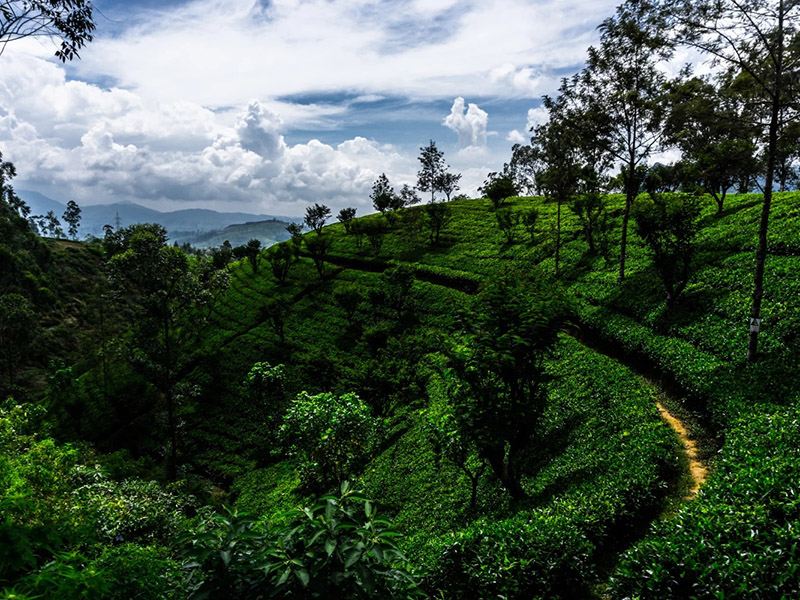Colors of the Emerald Isle (07 Days)
Colors of the Emerald Isle
07 Days & 06 Nights
All our tours are tailor made tour. We can customize this tour in Sri Lanka to suit your requirements. You can decide where do you want to go and how many days stay in Sri Lanka. As you wish, if you mention the names of the hotels you want to stay, we can reserve it for you.
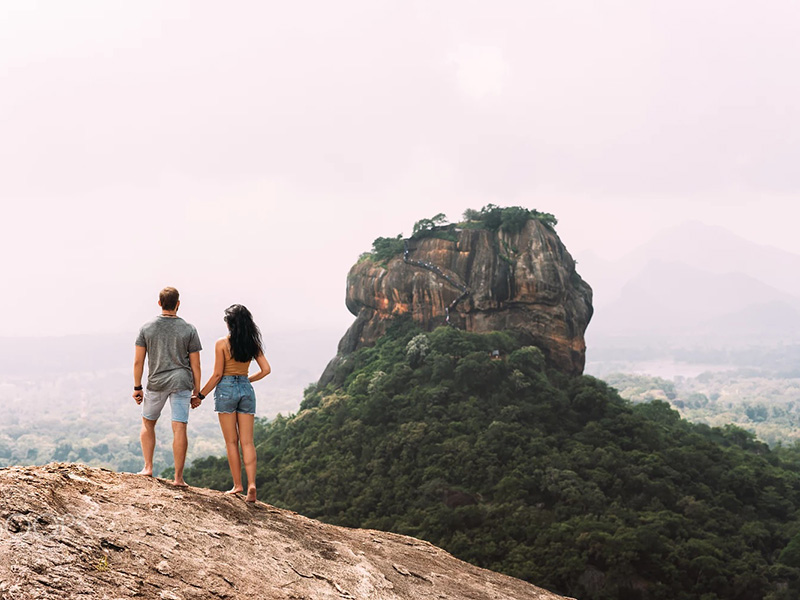
Those who want to see the tamed and a semi wild elephant in close proximity the best place is the “Pinnawala Elephant Orphanage”. It is located northwest of Kegalle town along the Colombo -Kandy main road. The orphanage is in a beautiful greenish land with fruitful twenty five acre coconut land and having grasses over the underground near Maha Oya. The wide area of shallow water and the huge rocks of Maha Oya make the ideal place to these magnificent animals. Elephant Orphanage was established in 16th February 1975 by the Department of Wild Life Conservation. At the beginning of orphanage there were only five orphan baby elephants those who brought from different places of the island. From the inceptions to date, Neela, Wijaya, Kadira, Mathali and Kumari are some of babies that were brought to the facility still living in the orphanage. Since then orphan elephants brought to the orphanage from different parts of the island and brought up at the orphanage. They were fed with milk as well as array of fodder.Today the heard has grown up to 69 elephants. Among the many elephants of the orphanage there are three of them which will definitely get your attention.
On arrival at the Bandaranaike International Airport, you will get your first taste of warm Sri Lankan hospitality; representative from Aliyah Tours will welcome you at the airport arrival lobby.
Transfer from Airport to Sigiriya.
On route we will visit Pinnawala Elephant Orphanage
Part hedonistic pleasure palace, part fortress and part sacred complex, Sigirya is one of the island’s most awe-inspiring archaeological sites and a leading tourist attraction. In fact some consider it to be one of the oldest tourist attractions in the world with early visitors recording their impressions as graffiti on a wall described as the world’s first interactive book. Located north of Dambulla, the site consists of a sheer rock that rises over 200m with the ruins of a palace on the top and a vast pleasure garden complex at the foot.
For just two decades in the 5th c.AD, Sigiriya rose to prominence following a power struggle between two brothers, and an act of patricide that saw the then king walled-up alive by his son, Kasyapa. Fearful that his defeated brother would return from exile to extract vengeance, Kasyapa shifted the capital to Sigiriya.
The Megalomaniac yet spiritual Kasyapa clearly had an eye for beauty. The Pleasure gardens include a series of symmetric pools, channels and fountains that still spurt water after 1500 years. Partway up the rock are the famous Sigiriya Frescoes, featuring 21 bare-breasted damsels that may represent celestial nymphs, but were surely modeled on Kasyapa’s own consorts. Halfway you’ll encounter a pair of giant Lion’s Paws, part of the original entrance, which required visitors to pass through the open mount of the lion. The summit yields a dramatic vista of the surrounding jungle and contains the foundations of the palace complex, replete with bathing pool. But all this was to be in vain. Kasyapa descended from his palace in the clouds to face his brother astride an elephant, eventually taking his own life when facing certain defeat.
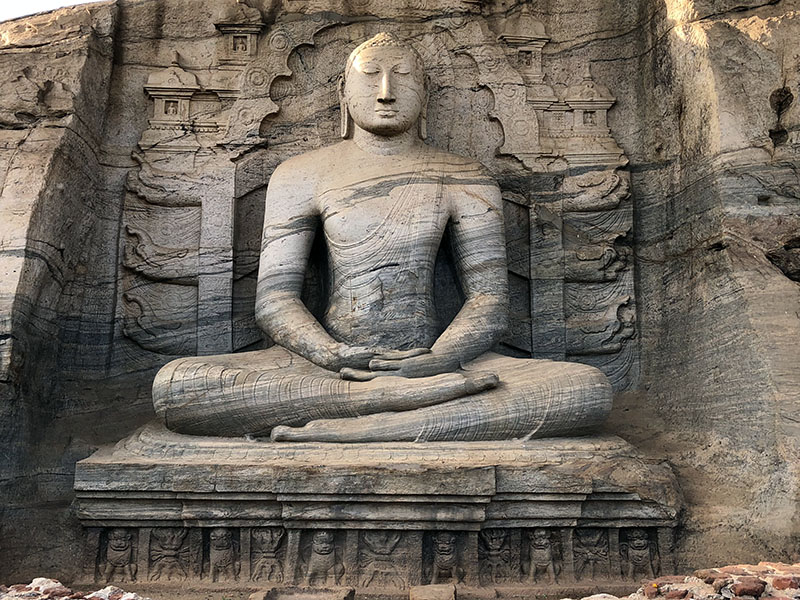
The next great capital which succeeded Anuradhapura and taken up for excavation and conservation by the Cultural Triangle Project is Polonnaruwa. Polonnaruwa was the medieval capital of Sri Lanka from the eleventh to the end of the first quarter of the 13th century AC. However, archaeological evidence suggests that there had been human settlements in Polonnaruwa even as far back as the second century BC. With the development of agriculture, Polonnaruva developed over the years as a vigorous agrarian economy. Both Anuradhapura and Polonnaruva came within the dry zone of the country and one of the formidable tasks the ancient rulers had to face was the conservation of the water necessary for agriculture. It is this exigency that led them to make the large and small reservoirs that lie scattered in the dry zone.In the fourth century AC, king Mahasena, the great tank builder, built the Minneriya reservoir not far from Polonnaruva. Some other reservoirs in and around Polonnaruva were also the work of Anuradhapura kings. This provided the farmers ready access to the much needed water, which resulted in a flourishing agrarian economy that makes them self-sufficient.
King Parakramabahu I combined three small tanks and built the largest reservoir called the ‘Sea of Parakrama’ of which you can have a panoramic view from the lounge of the Rest House in Polonnaruwa.Today the ancient city of Polonnaruwa remains one of the, standing testimony to the discipline and greatness of the Kingdom’s first rulers. The ancient city of Polonnaruwa has been declared a World Heritage site by UNESCO.Polonnaruwa is the second largest city in North Central Province, but it is known as one of the cleanest and more beautiful cities in the country. The green environment, amazing ancient constructions, Parakrama Samudra and attractive tourist hotels and hospitable people, attract tourists.

After breakfast we will get experience with Village tour and Elephant Back Safari & then we will transfer to Pollonnaruwa
Elephant Ride in Sri Lanka is a very popular activity among the children and also one the favorites of the adults. The scenery Elephant Ride is not only a ride; it is a marvelous way to explore the Sri Lankan nature. You will get a chance to ride thought wildest regions and attractive riverside scenery if you are dreaming to have a ride with this intelligent mammal; this is the best chance you will ever get. While you are on round tour, don’t forget to enjoy the Elephant Ride as it will be a memorable activity witch you ever have. The best places for Elephant Rides are Sigiriya and it is a delightful experience as this riding path moves through lakes, villages and wildlife.
Bullock Cart is the first vehicle in Sri Lanka, in the past once famous mode of transport of local royalty. Today this vehicle have become coordinating between the past and present. When you visit the great Sigiriya Rock, you can see a fortress that stands up in the wilderness. Where once upon a time, an aesthetic king built his hideaway to rule his kingdom, even today Sigiriya stands like a sentinel in the sky your experience begins the village called Ehelagala. It adjacent to the freat “Sigiriya Rock” you can ride the bullock cart in gravel path becomes the dust red soil of a bund. A line of black and makes its way across it, disappearing in to the grassy verge, flit between the a hive of activity butter files flit between the wild flowers, their wings coalescing and separating, in a kaleidoscope of colour. You can see many animals and birds; in the jungle. In the distance and the seemingly endless expanse of cool, cool green. Meander along the grassy bank of the picturesque Ehelagala for a truly satisfying birding experience. Reservoir is a stunning mixture of the village after the cart ride visitor can get a canoe boat ride in the reservoir.
Then visitor can get experience of the pleasures of village life. Visit a poor house in the village. You can see a farmer going to his rice field with a hoe on his shoulder and his wife making the lunch to him. You can get enjoy the village tour and have a simple home cooked meal and village drink by journeying into the heart of Ehelagala. At the end visitor have a Tuk Tuk tour or Hand Tractor tour back to the starting point.
Like Minneriya, Kaudulla offers a good chance of getting up close and personal with elephants. Kaudulla National Park, 6,900 hectares in extent, is one of the more recently established National Parks in Sri Lanka. This park stands on the fringe of the ancient Kaudulla Wewa, It is situated in the North Central Province, just 30km away from Polonnaruwa. Kaudulla is historically important as it is one of the famed 16 irrigation tanks built by King Mahasen. The tank which dominates the background of the Park is an important meeting place for hundreds of species of wildlife which popularly includes hundreds of Elephants who come to water at the reservoir, especially during the dry seasons.
Kaudulla National Park famous for migrating Elephants from Minneriya National Park in the North Central Province and Wasgamuwa National Parks in the Central and the Somawathiya National Park in the north east regions. The best time to visit the park is between August and December, particularly during September and October when the largest gathering of Elephants can be witnessed.

Visit a spice garden in Matale to see different spices for which Sri Lanka is famous for. Clients will be able to see different spices and how some of these spices are grown and processed. Learn about the local plants and their culinary and medicinal uses from your guide as you go. . Witness a Cookery demonstration that puts the plants to good use and eat lunch. This culinary tour is an ideal way by which the discerning traveler can immerse himself or herself in the history and the ethos of Sri Lanka, its people and their customs and of course most importantly their food. You can learn about Sri Lankan spices and various Sri Lankan cookery methods.

After breakfast you will transfer to Dambulla. On route you will visit a spice garden.
Dambulla rock temple has been built in the 1st century B.C. and it is a world heritage site. Also, it is the most impressive of Sri Lanka’s cave temples. Hewn into a 160m granite outcrop are the remarkable cave temples of Dambulla. Located at the centre of the Island and on the main route north to Anuradhapura and Polonnaruwa, the cave temples are masterpieces of Buddhist art. Each is filled with murals depicting scenes from the Buddha’s life, and gilded statues of the Buddha in various poses.
In the 1st c, BC, the Dambulla caves provided refuge to a king who fled a south Indian invasion. On reclaiming his throne, the grateful king had temples constructed in the caves that had sheltered him. These were embellished by subsequent rulers, especially during the Kandyan period in the 17th and 18th centuries.
Altogether, there are five caves. A cave 2, the Maharaja Vihara is the largest and most spectacular at over 50m long, 7m high and almost 25m deep. The spiritual energy at Dambulla is palpable and the Buddhist art on display is unparalleled in Sri Lanka. An added bonus is the majestic view from the top of the rock. The complex of five caves with over 2000 sq. meters of painted walls and ceilings is the largest area of paintings found in the world. It contains over 150 images of the Buddha of which the largest is the colossal figure of the Buddha carved out of rock and spanning 14 meters.
Nestled in lush green hills and built around a scenic lake, the Royal City of Kandy, at 500m above sea level, is the hub of any visit to the hill country. Kandy, a UNESCO World heritage Site, was the last bastion of resistance to colonial rule, surviving two centuries of colonial incursions by the Portuguese and the Dutch before falling to the British in 1815. Even today, Kandyans pride themselves on their distinctive architecture, music, dance and art.
The showpiece of the city is the Dalada Maligawa or Temple of the Tooth Palace, which hosts the Lord Buddha’s tooth relic, an item of veneraltion to all Buddhists, is an experience no tourist should miss. Said to have been snatched from the Lord Buddha’s funeral pyre and smuggled to Sri Lanka in the hair or a princess, the tooth relic is of great spiritual significance. Strolling around the lake or exploring the numerous temples that dot the hills nearby is a great way to get the feel of this historic city. Each Year, in August, the city holds the Esala Perahera (procession), a spectacular display of medieval Pageantry replete with caparisoned elephants, whirling fire dancers, and pulsating drummers.
Visit Bazaar area, Arts & crafts centre, a Gem museum and a lapidary etc.
In the evening visit Temple of the Tooth Relic. Late evening witness the Cultural Show, experiencing the pulsating drum rhythms and colorful traditional dances at a cultural show is another must.
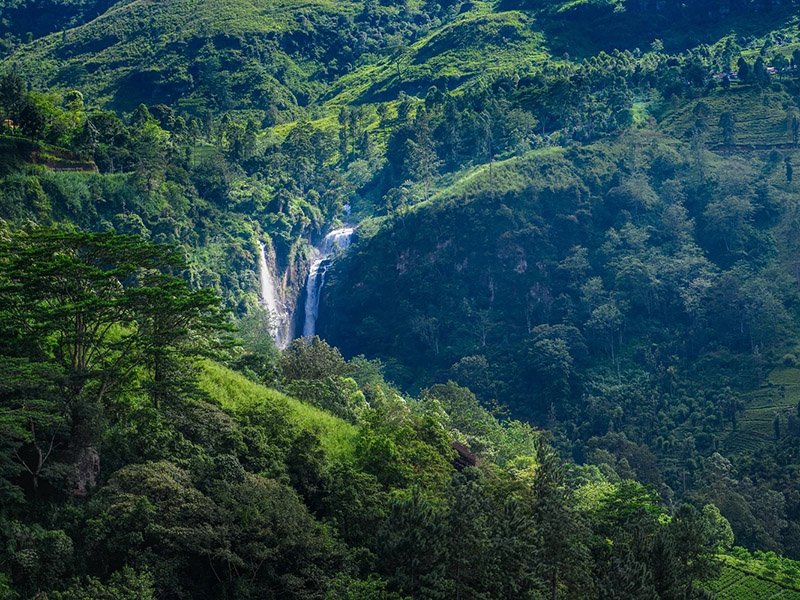
Among the most iconic vistas of hill country are the rolling tea estates that carpet vast swathes of estates that carpet vast swathes of terrain in an emerald sea. Women draped in colorful saris resemble butterflies as they work their way deftly along the tea bushes, picking just two leaves and a bud from each branch and tossing them into the baskets slung on their backs. Introduced to the island in the late 19th century by the British, tea remains of vital importance to the economy.
Some of the finest teas in the world are produced in the hill country and a visit a Tea Factory during a trip to plucked tea is dried, crushed fermented and fired using machinery that has remained largely unchanged since Victorian times. Sri Lanka is world famous for Ceylon Tea. Clients will be shown a tea plantation & a factory. You will be able to witness the processing of Tea and also taste a cup of nice & hot Ceylon Tea. You can buy various different Tea products from the Tea shop.
Sri Lanka is blessed with over one hundred waterfalls. Ramboda Ella is the 11th highest waterfall in Sri Lanka and 729th highest waterfall in the world. The fall is height about 109m and height from Sea Level: 945m.This gigantic water fall consists of three sections.
This unique and beautiful sight can be seen at the Pussellawa area of Nuwara Eliya, at the Ramboda Pass. The Ramboda Falls or Ramboda Ella or Puna Ella as these falls are called is created from Puna Oya, a branch of Kothmale Oya. It makes a twin with Dunsinane Falls which is created by Pundalu Oya, also a branch of Kothmale River, and combines at the base to form a Y shape.
During normal periods of the year Dunsinane Falls which falls on the right receives more volume of water than Ramboda falls. However during periods of drought the role is reversed as Dunsinane Falls, whose branch passes through farming lands before falling, has less water coming through compared to Ramboda Falls whose branch passes through a forest reserve. In this case, instead of Ramboda Falls having more water it is more due to Dunsinane receiving less water while Ramboda remains the same.
After breakfast you will transfer to Nuwara Eliya. On route visit Royal Botanical Garden, Tea Factory & Ramboda Falls
The history of the Royal Botanic Gardens dates as far back as 1371 when king Wickramabahu III ascended the throne and kept court at Peradeniya near Mahaweli River. Later, in the reign of King Kirti Sri Rajasinghe from 1747 to 1780 this was made a Royal Garden and from 1780 – 1798 King Rajadhi Rajasinghe resided therein, where a temporary residence was erected for him. This was a pleasure garden of a Kandyan King of the 16th Century and later made in to a Botanical Garden during the British regime.
The most amazing of the Garden have, Flower Garden, Palm Avenues, Plant House and Cacti, Bamboo Collection, Orchid House and Gardens, Fernery, Great Lawn, The lake, Spice Garden and Flowering Trees and the Arboretum.
The most spectacular of the Gardens are the flowering trees which come into bloom at various times with peak blooming during the first half of the year. Amherstia nobilis popularly known as the Pride of Burma is the finest and a row of this is found planted near the main entrance. An extensive Arboretum of 20 ha in extent contains approximately 8000 trees. Some of these trees are magnificent specimens which are over 100 years old.
Nuwara Eliya is located at the heart of the hill country 6182 feet above from the sea level. At the heart of the southern hill county is Nuwara-Eliya, Sri lanka’s highest town and a favorite hill station during British colonial times. It is still very much like an old English town with styled Bungalows and buildings. The cool calm climate, gorges rolling tea plantation which makes the best “Ceylon tea” and the breathtaking beautiful waterfalls makes Nuwara Eliya one of the most beautiful town in the world. The town is still touted as ‘Little England’, an illusion maintained by the presence of the finest 18 whole golf courses in South Asia, a racecourse, the Victoria Park and excellent trout fishing in nearby lakes and rivers. The temperature can drop to close to freezing at nights and it is common to se smoke rising from the chimneys of many Tudor-style manors. Adding to the town’s atmosphere is the spectacle of its townsfolk wrapped up in winter jackets and woolly hats, carting great bundles of turnips, leeks, marrows and cabbages to and from the markets. Nuwara Eliya is a great base to explore the surrounding countryside and there are many walks on offer, including hiking around the lower slopes of the thickly forested Mount Pidurutalaga, at 2,555m the island’s highest peak.
You can visit the Golf Club, Strawberry Farms. You can take a nice evening walk around the Gregory Lake. We can arrange horse ride, boat ride and Cycling.

British constructed the railway lines in Sri Lanka and today it stands as one of the most scenic journeys to be done on rail in the world. The views on both sides of the rail are breathtaking. The train winds through the mountains overlooking farms and villages and of course vast tea plantations. The scenery changes throughout the trip. Often at times, you are looking out at an entire green view than the next minute you are in the middle of a green forest. The train also passes through several tunnels. As well as often you can see the waterfalls too.
The Demodara Nine Arch Bridges close to Ella station is as picturesque as bridges get. The bridge was constructed in the early 1900’s and is built completely out of rocks and cement without a single bit of steel. The views from the window will have you snapping photos at every turn. Therefore we facilitate our clients to get that experience.
After breakfast at Hotel transfer from Nanu Oya to Ella by train.
On route you will stop at the Rawana Falls
The 25m-high Ravana Falls cascades from an oval-shaped concave rock outcrop. Kirinidi Oya is the water course for this beautiful cascading waterfall. It currently ranks as one of the widest falls in the country. This waterfall measures approximately 25 m (82 ft) in high and cascade from an oval-shaped concave rock outcrop. During the dry season water level reduces drastically and Ravana falls becomes very skinny, but again becomes majestic during the upstream rainy seasons. In the dry season, the flow of water is markedly reduced, whereas rain turns the fall into what is said to resemble an area flower with withering petals. But this is not the case in the wet season, where the flow of water reduces dramatically.
The falls is a part of the Ravana Ella Wildlife Sanctuary, and is located 6 km away from Ella Railway station. Many of the Sri Lankan waterfalls can be spotted in middle of the jungle, with some lengthy routes. But since this falls is located just next to the main road, everybody can reach this without any trouble. So this becomes very popular sightseeing spot for photography.
The falls have been named after the legendary character Ravana, which is connected to the famous Indian epic, the Ramayana. According to story, it is said that Ravana (who was the king of Sri Lanka at the time) had kidnapped princess Sita, and had hidden her in the caves behind this waterfall, now simply known as the Ravana Ella Cave. At the time, the cave was surrounded with thick forests in the midst of wilderness. It is also believed that Rama’s queen bathed in a pool that accumulated the water falling from this waterfall. Locals who are traveling to upcountry used to stop by the Ella and get shower at here, so you can stay,relax and refresh and continue your journey.

Then we will proceed to Galle.
In the evening you can visit Dutch Fort at Galle.
The 16th c. Dutch Fort at Galle, close to the island’s southern most point has the distinction of being the best-preserved sea fort in South Asia. Enter through the imposing stone bastions that encircle the sea-facing promontory and step back in time. Inside the Fort you will find that it exudes old-world charm. The narrow streets are dotted with Dutch colonial villas and there’s a welcome absence of vehicular traffic. There are several museums and antique shops that display curiosities from the island’s colonial era. Of the many colonial buildings, perhaps the most absorbing is the Dutch Reformed Church, containing ornately carved memorials to the city’s Dutch settlers. The Fort also hosts some of the island’s most exclusive boutique-style accommodation in former villas restored to their colonial glory.
The Portuguese established the first fort in Galle. This was captured by the Dutch in 1640, after which the fortifications were expanded and the grid street system established. Further extensions were made during the British period. The passenger port gained importance, but with the construction of a breakwater at Colombo, Galle slipped into maritime decline. Stroll along the massive ramparts at dusk. Experience the tranquil ambience of a bygone era yet see life as it proceeds: children flying kites, games of softball cricket, and couples canoodling behind the privacy of umbrellas. They all seem to enhance the magic of the fort.
After Breakfast, you will leave for the whale and dolphin watching.
Mirissa and its magnificent sandy beach cute much transform your imaginings and visions of a tropical paradise into an everyday reality. Mirissa Located close to the Southern tip of the Island of Sri Lanka and only about 200 km from the Equator, this beach is the perfect place to sit back, relax and forget about all the hustle and bustle of your other life that’s a million miles away. This small tropical beach boasts some of Sri Lanka’s most excellent and most.
Since of late it has become the best place in the world to observe the mighty Blue Whale, as it has come to be that unlike other places where they roam, most of the Blue Whales in Sri Lanka do not migrate. They can be found residing among other whales and all kinds of dolphins.The ever cheery, playful dolphins will put on a show while some of the oldest and the largest marine creatures, the humpback and the blue whales, will nonchalantly glide past you, when you embark on a whale/dolphin watching excursion off the Southern coast of Sri Lanka. The perfect locations for whale watching would be Mirissa.
With the whale watching season (November to April / May to October) in Mirissa being in full swing and many local and foreign tourists gathering to the Mirissa harbor, The Sri Lanka Coast Guards had increased their vigilance in monitoring the implementation of whale watch, and manage policy. To ensure that the system is adhered to by boat operators and tourists occupied in whale watching.

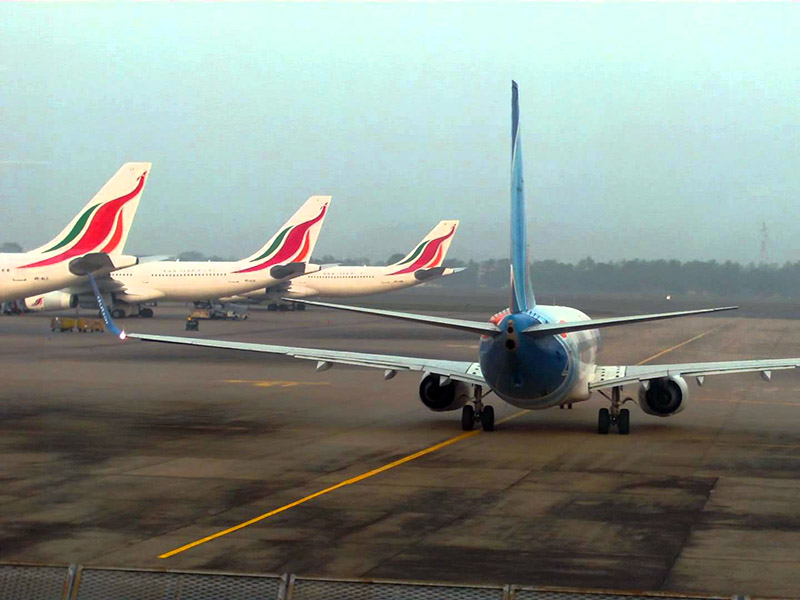
Seven species of sea turtles representing two families, Dermochelyidae and Cheloniidae are the only living members among the turtles. These seven species include the largest among the turtle, the leatherback and the smallest, the olive ridley turtle. The other five species are the hawskbill turtle, green turtle, loggerhead turtle, Kemp’s ridley and flatback turtle. Five of the seven known species of sea turtles are reported form the Sri Lanka. All the species of sea turtles found in Sri Lanka are presently endangered and are protected by law.
In the afternoon, do city tour of Colombo. Colombo is the commercial and business center of Sri Lanka located on west coast. The city blends together with old colonial type building, high-rise commercial buildings and hotels. It is filled with shopping malls. Some of the finest structures built during the colonial times still preserved in one part of the City. For example, there is a 100-year-old clock tower, and the Bandaranaike Memorial International Conference Hall (BMICH) which was a gift to Sri Lanka from the People’s Republic of China.
After breakfast at Hotel transfer to Bentota.
On route we will stop at Meetiyagoda Moonstone Mine and Kosgoda Turtle Hatchery.
Have you ever wondered where that pretty little moonstone on your finger actually comes from? Head inland 7km to Mitiyagoda and you can descend into the mucky world of mining – 18th-century style! Moonstone has been mined in these sweltering forests forever and the moonstone mines, little more than muddy rabbit holes, 6m or 7m long, are fascinating – as is the process of filtering out the precious stones, cutting them up and polishing them up ready for sale. Entrance is free, but expects a hardcore sales pitch in the on-site shop afterwards. To get there head towards Kahawa and turn inland to Mitiyagoda after which it’s clearly signed
The estuary of the Madu Ganga River is a complex coastal ecosystem of mangroves and islands. It is situated in and around Balapitiya in the Southern Province within the Wet zone of Southern coastal belt of Sri Lanka. It passes through the wet zone of Sri Lanka opening up into the large Madu Lagoon on its way to the Indian Ocean Maadu Estuary is perhaps one of the last remaining tracts of pristine mangrove forests in Sri Lanka, with a rich biodiversity. The Madu River is very rich in biodiversity.
History states there used to be 64 islands along Madu River. However most seem to have sunk under the water, as only 25 islands are reported today and all are covered in forests and shrubs. One of the larger populated islets, ‘Koth Duwa’, houses a Buddhist Temple that dates back to the days of the oldest kings of the country. Meanwhile two other islets bear the history of the country by have been the refuges to two different kings, King Dhathusena and King Mugalan.
Welcome the guests at the Airport by a Representative of Aliyah Tours
All Local Transfers and Sightseeing by an air-conditioned vehicle throughout the tour
Entrance Fees for Sights Visited
Visit according to the program
One litter water bottle per day
Highway Tolls
All Local Taxes
Air tickets and insurance
Immunizations / Medical
Meals and accommodation
Video camera permits
Vehicle use for night life activities
Porter rage & Tips
Cost of beverage throughout the tour
Expenses of a personal nature
Any other services not specified above
Client should pay 50% of tour amount at the arrival and the rest can be paid during the tour or at the Airport where you’re ready for the departure.
You should provide accommodation and meals for the driver.
Cancellations within 01 to 06 days of the arrival date – 100% of the value of the booking
Cancellations within 07 to 13 days of the arrival date – 50% of the value of the booking
Cancellations within 14 to 28 days of the arrival date – 25% of the value of the booking
Cancellations beyond 30 days of the arrival date – not charge

